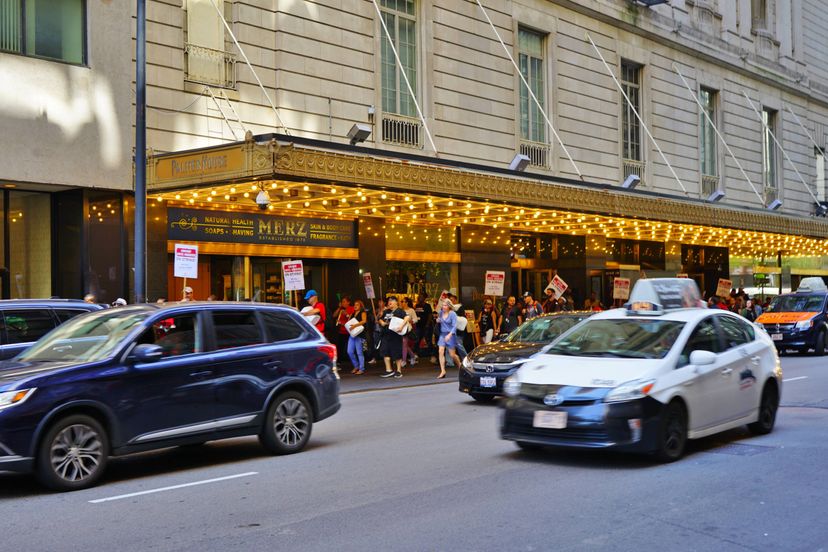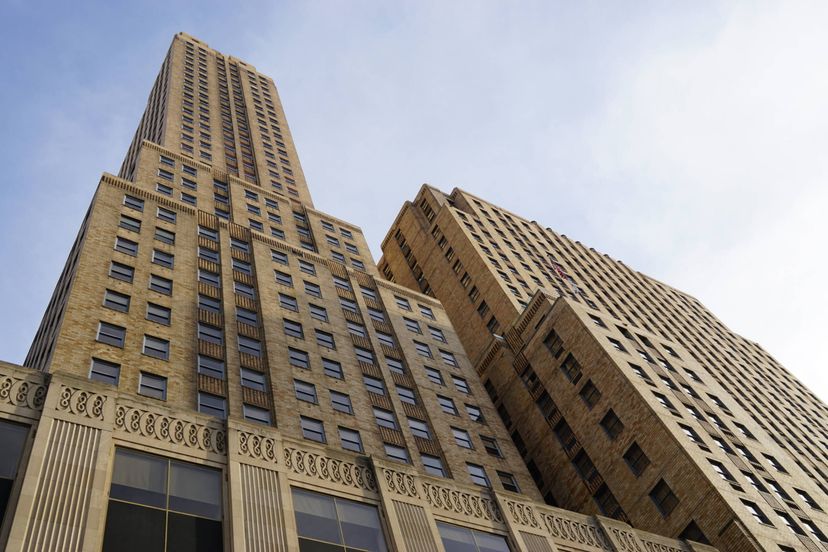
With a long history as an industrial manufacturing hub, the U.S. Midwest also is home to some of the nation’s finest hotels. But just as the fortunes of the region’s business barons have risen and fallen over the decades, so have many of its longest-standing hotels. Some of the Midwest’s most revered, historic hotels narrowly escaped fires, the Great Depression, and the wrecking ball, but today, they are better than ever thanks to a new generation of forward-thinking preservationists. Here are 10 amazing historic hotels in the Midwest that are still open for business, and the stories behind them.
Advertisement
10. Palmer House Hilton (Chicago, IL)

The iconic Palmer House Hilton in downtown Chicago got off to a most inauspicious start when the elegant hotel fell victim to the Great Chicago Fire of 1871 only 13 days after its grand opening. But, business magnate and owner Potter Palmer quickly rebuilt the 1,641-room hotel which opened in late 1873 and has been a landmark ever since. Palmer’s wife Bertha decorated the hotel with opulent chandeliers, paintings, and other art inspired by her French heritage including a majestic ceiling fresco by painter Louis Pierre Rigal. The decadent hotel has hosted everyone from Charles Dickens and Oscar Wilde to U.S. presidents, and top entertainers such as Liberace, Frank Sinatra, Louis Armstrong, and Ella Fitzgerald performed in its Golden Empire Room. A $170 million renovation has ensured the Palmer House’s place among the top hotels to be found anywhere. Afternoon tea in the lobby is not to be missed.
9. Hilton Cincinnati Netherland Plaza (Cincinnati, OH)

Some hotels stand the test of time as a stunning architectural design achievement, like the Hilton Cincinnati Netherland Plaza, an Art Deco masterpiece that’s a registered National Historic Landmark. Elaborately decorated with rare Brazilian rosewood paneling, two-story ceiling murals, and original German silver-nickel sconces, the circa 1931 hotel in downtown Cincinnati is one of the world’s finest examples of French Art Deco style. Its Orchids at Palm Court is among the most beautiful restaurants in America, made even more memorable by Chef Todd Kelly, named the America Culinary Federation’s Chef of the Year (2011-12). The opulent Hall of Mirrors ballroom has been at the heart of Cincinnati’s business and social scene for over 80 with its two-story ceilings, mezzanine, and original light fixtures. The Netherland Plaza is connected to the 49-story Carew Tower which opened in 1931 and has an observation deck with sweeping views of the Ohio River Valley.
8. French Lick Resort (French Lick, IN)

The mineral spring waters that abound in French Lick were once thought to be the elusive Fountain of Youth due to their reported restorative and healing qualities. This attraction gave birth to the luxurious French Lick Resort that opened in 1845 and continues to be a destination for travelers seeking memorable accommodations. The 443-room hotel was restored to its original grandeur via a $382 million restoration and expansion project that added a 42,000-square-foot casino and restored and reopened the historic “Hill” golf course that originally opened in 1917. Prior to the restoration, the hotel had declined under several different owners. Over the years, it has hosted numerous dignitaries and historic events including the 1931 Democratic Governors Conference where Franklin D. Roosevelt secured support for his party’s presidential nomination. Today, the opulent resort has an array of amenities including a 27,000-square-foot, world-class spa with 24 treatment rooms.
7. Westin Book Cadillac (Detroit, MI)

The story of most buildings that stand idle for a quarter-century rarely ends well, especially a luxury hotel like the Westin Book Cadillac in downtown Detroit. Originally opened in 1924 as the tallest building in Detroit, the 33-story Hotel Book-Cadillac played host to eight U.S. presidents and the likes of The Beatles, Elvis Presley, Babe Ruth, and Dr. Martin Luther King, Jr. during its heyday. It boasted more than 1,200 rooms as well as three ballrooms and various restaurants and shops. Its Italian Garden and Venetian Ballroom incorporated architectural elements from Europe, and the hotel was featured in “State of the Union” in 1947, starring Spencer Tracy and Katharine Hepburn. Alas, it closed in 1984 as Detroit’s own fortunes began to wane, only to be reborn in 2008 after a $190 million project restored it. Today, it features 455 hotel rooms and 67 luxury condos.
Advertisement
6. Hilton President Kansas City (Kansas City, MO)
Known as the Hotel President when it opened in Kansas City in 1926, the Hilton President Kansas City has lived up to its name. The 453-room hotel hosted the 1928 Republican National Convention where Herbert Hoover received the party’s nomination. Three other U.S. presidents—Eisenhower, Truman, and Nixon—have either stayed or visited the opulent hotel. Its Drum Room lounge became equally famous after opening in 1941, hosting the likes of Benny Goodman, Tommy Dorsey, Glenn Miller, Frank Sinatra, and Sammy Davis, Jr. The hotel closed in 1980 but soon was reborn as a smaller, 213-room luxury hotel following a $45 million restoration. Located in Kansas City’s vibrant Power and Light entertainment district, the Hilton’s immaculate lobby and mezzanine were meticulously restored, and its elegant Congress Ballroom features the original terrazzo floors installed in 1926. It’s Walnut Room restaurant features original stained glass and majestic wood columns as well.
5. West Baden Springs Hotel (West Baden Springs, IN)
Some hotels are famous for their history or their uniqueness and a few like the West Baden Springs Hotel are noted for both. The current West Baden Springs Hotel opened in 1902, but a hotel has occupied the site since 1855. In 1888, it was upgraded to a grand resort for the elite, complete with a casino and opera house. It burned to the ground in 1901 and was rebuilt just a year later with a spectacular circular design topped by an awe-inspiring 200-foot, a free-span dome that was touted as the eighth wonder of the world. The Depression forced the closure of the hotel in 1932 and it later served as a seminary and private college. It reopened in 2007 as part of a special casino district in Indiana after a massive restoration. The luxurious, 246-room hotel now features a formal garden, an 8,000-square-foot spa, and a 12,000-square-foot indoor pool.
4. The Pfister Hotel (Milwaukee, WI)
When the Pfister Hotel opened in downtown Milwaukee in 1893 at a cost of nearly $1 million, it created quite a stir with unheard of features like individual thermostat controls in each guestroom and electricity throughout the hotel (imagine that). Sporting a Romanesque Revival style, the Pfister also had two billiard rooms (one for both sexes) and a private bar for men only. Owner Charles Pfister utilized the hotel bearing his name to showcase his extensive art collection. Today, the Pfister’s priceless Victorian art is among the world’s top hotel art collections. In 1962, theater operator Ben Marcus purchased the aging hotel at auction. He restored the grand dame of Milwaukee hotels and added a 23-story guestroom tower. The 307-room hotel is now better than ever, with a top-notch spa and a 23rd-floor martini and wine bar with great views of Lake Michigan.
3. Omni William Penn (Pittsburgh, PA)
The Omni William Penn Pittsburgh was once the largest hotel between Pittsburgh and Chicago, with 1,600 guestrooms, when its 600-room, Grant Street Annex addition opened in 1929. The original hotel, opened in 1916 at a cost of $6 million, was industrialist Henry Clay Frick’s dream to build a Pittsburgh landmark to rival the Old World elegance he saw in European hotels. He hired noted architects Franklin Abbott and Benno Janssen to design the hotel, and he spared no expense. The Grand Ballroom on the 17th floor of the original hotel has been lavishly restored. With huge crystal chandeliers and opulent gold and white décor on two levels, the large ballroom looks like a scene from “The Great Gatsby.” Traditional afternoon tea is served at the William Penn, which recently received a multi-million-dollar renovation. It now has 597 guestrooms, 52,000 square feet of function space, and multiple restaurants.
2. Renaissance Cleveland Hotel (Cleveland, OH)
Hotels have occupied the corner of Superior and Public Square in the heart of downtown Cleveland since 1812. Its current occupant, the Renaissance Cleveland, opened in 1918 as a 1,000-room luxury hotel with vaulted ceilings, high arched windows, and an impressive marble fountain in the lobby. It is connected to the Terminal Tower building that opened in 1930 as the city’s rapid transit center. Today, the 52-story Terminal Tower is known as Tower City Center and features shops, restaurants, cinemas, and casinos. After going through several names and owners over the years, the original Hotel Cleveland remains a luxury hotel with 441 guestrooms with marble bathrooms, 50 suites, and three ballrooms among 64,000 square feet of function space. Its aptly-named Grand Ballroom can seat 2,900 people. Its San Souci restaurant features fine dining in elegant surroundings including pastoral murals and wood columns.
Advertisement
1. Omni Severin Hotel (Indianapolis, IN)
The Omni Severin Hotel is one of the last original buildings standing in the Indianapolis Union Station Wholesale District. Built by Henry Severin, Jr. with help from the founders of the famed Indianapolis Motor Speedway, the hotel originally opened in 1913 as the Grand Hotel of Indianapolis. It thrived as a daily stream of train passengers arriving at adjacent Union Station needed a place to stay, and it continues today as the city’s longest-running luxury hotel. Severin’s history is on display throughout the hotel. The original marble staircase remains, as does the crystal chandelier hanging outside the Severin Ballroom. The original 1913 mailbox serves as a working mailbox today, and original furniture from the hotel rests outside the elevator on each floor of the 424-room hotel. Completely modernized while retaining its historic charm, the Severin is connected via skywalks to the downtown Circle Center Mall and Indianapolis Convention Center.
Advertisement